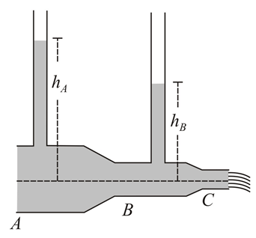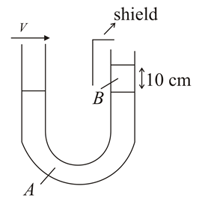Water flows through a pipe as shown in the figure. The areas of cross-section of sections and respectively are and . The gauge pressure in the pipe at the centre of section is and the flow rate is . The difference in heights of the water levels in the vertical pipes is_____ . (Acceleration due to gravity )



Important Questions on Mechanical Properties of Matter
A -tube open at both the ends is partially filled with a liquid of density . Another liquid of density is poured into one of the arms and it forms a column of length as shown in the figure. If the arm into which liquid is poured is shielded from any air motion, the speed with which air should be blown across the top of the other arm till the levels of the two liquids are at same height in is (Density of air is , Acceleration due to gravity )

A flat plate of area is separated form a large plate by a layer of Glycerine thick. If the coefficient of viscosity of Glycerine is poise, the force required to keep the plate moving with a velocity of is
(a) Angle of contact depends upon the inclination of the solid surface to the liquid surface.
(b) If the angle of contact of a liquid and a solid surface is less than then the liquid spreads on the surface of the solid.
(c) Angle of contact increases with increase in temperature of liquid.
(d) The value of angle of contact for pure water and glass is zero.
